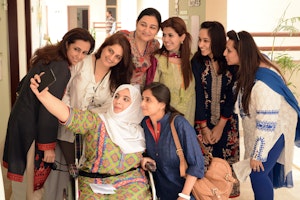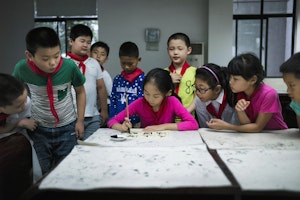The Stabilizing Power of School for Children with Disabilities in Pakistan
By Faisal Bari

A girl from a poor household in rural Balochistan, Pakistan, is likely to have a very different life than a boy born to a rich family in an urban center like Karachi or Lahore.
To start, the girl from Balochistan is significantly more likely to die as an infant. If she survives infancy, her chances of going to school are small. Even if she enrolls, she will most likely drop out before she finishes the primary grades. In fact, the odds that she’ll make it to 10th grade are vanishingly slim.
Her economic and social standing will probably never rise, even with marriage, and she faces a significant chance of dying while giving birth. She is likely to be malnourished as a child and anemic as an adult.
Now imagine that same child has a mental, physical, or learning disability. Even in a city, she would struggle. In a rural area, the odds against her will be stacked incredibly high.
Six years ago, Pakistan added Article 25A to its constitution. It promises a “free and compulsory education” to all children between five and sixteen years old. Since then, provincial governments have worked on enrollment drives to get more children into schools.
The drives have been so focused on enrollment that quality concerns have sometimes been neglected. Nevertheless, enrollment—especially at the primary level—does seem to be rising. Recently, the UN’s Sustainable Development Goals have added to the urgency of achieving enrollment targets.
Some of the provincial governments have found that, for all their success in enrolling students, however, it’s difficult getting those last 15 to 20 percent of children into school. One hypothesis is that these are children who are especially marginalized by disability—children who can’t be reached with typical enrollment drive incentives.
This challenge has spurred interest in inclusive education. The idea is to ensure that children with up to medium-level challenges (a vaguely defined classification) are identified and teachers are trained to address their needs. Pakistan’s inclusive education programs are still in the pilot stage, but provincial governments hope to scale them up in the coming years.
The Institute of Development and Economic Alternatives, in collaboration with experts at the University of Cambridge, is undertaking research to identify different forms of marginalization that affect the life-chances of children in rural areas. They are studying how schools and teachers currently deal with the needs of such children, and, most importantly, what best practices in inclusive education can be learned and more widely applied.
Though the work is still underway, preliminary results show that, of 1,549 children aged eight to twelve in three rural districts of Punjab, 495 report some form of physical, mental, or cognitive challenge, a significant number of these falling into the low- or medium-challenge categories.
The majority of children reporting any form of challenge were from the lower three income quintiles, and almost 88 percent of them were enrolled in school. Problems that were easy to fix, like correcting poor eyesight with glasses, were usually dealt with. But disabilities that were harder to diagnose (mostly mental) or harder to deal with (such as disabilities requiring surgical or other interventions) usually went unaddressed.
I met Zehra, the 11-year-old daughter of a laborer. When she was enrolled in the first grade, four years ago, she was evaluated by her teachers as “quite slow.” She was not. She was just a shy child who could not read what was written on the blackboard.
One day she had a seizure in class. Her teachers threw her out of school, thinking she had severe mental problems. Her parents did not take her to a doctor until she was 10. The doctors discovered that Zehra needed glasses and that she suffered from epilepsy. She had no mental challenges at all.
Now, armed with glasses and epilepsy medication, Zehra is raring to go, though she has already lost four to five years of schooling. Even a basic early-detection program could have helped her in time.
Though inclusive education has caught the interest of officials, there remains some resistance from teachers who are skeptical of having children with disabilities mainstreamed in their classes. In almost 20 percent of government schools in the Punjab, the most advanced of Pakistan’s provinces, teachers oversee children from more than one grade.
Given their overwhelming responsibilities, these teachers’ reluctance is understandable. This is why we also aim to develop material that will help teachers better manage diverse classes.
Our hope is that this research project will highlight the importance of inclusive education, and offer relevant and practical ways to ensure children get the inclusive education they deserve. Disabilities can be especially challenging for poor, rural children in Pakistan. But the stabilizing power of schooling could change that. Getting them into schools is the first step.
The Institute of Development and Economic Alternatives is a grantee of the Open Society Foundations.
Faisal Bari is a senior research fellow at the Institute of Development and Economic Alternatives.


